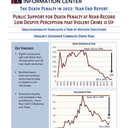David Garland, a professor of law and sociology at New York University, recently addressed some common myths regarding the death penalty in America. In an op-ed in the Washington Post, Garland provided information challenging the common wisdom about capital punishment:
The United States is a death penalty nation. Garland contends that, in fact, the death penalty is rarely imposed today. It has been abolished in 15 states and in the District of Columbia. Of the 35 states that have the death penalty, one-third rarely impose death sentences, and another one-third impose death sentences but hardly ever carry them out. Eighty percent of executions are carried out in the South, largely in Texas and in Virginia.
The United States is out of step with Europe and the rest of the Western world. Since 1981, when France stopped executing people by the guillotine, Europe has been an abolitionist continent. However, for most of the past 200 years, American states have been actively working towards death penalty reform. Michigan abolished the death penalty for all ordinary crimes in 1846, a century before most European nations did so.
This country has the death penalty because the public supports it. Even though polls show that a majority of respondents say they support the death penalty, it is less clear whether people are well-informed about the issue, have given the matter much thought, or have considered alternatives to capital punishment.
The death penalty works. “[I]t stretches credulity to think that the death penalty, as administered in the United States today, can be an effective means for deterring murder — the only crime for which it is available. Last year, there were more than 14,000 homicides in the nation but only 106 death sentences. The chances of any particular killer being caught, convicted and sentenced to death are vanishingly small.”
The death penalty doesn’t work. Among the possible “benefits” of the death penalty, the author states, “Politicians give voters what they want by enacting capital punishment statutes even when they will never be enforced. Prosecutors use the threat of a death penalty as leverage to elicit plea bargains and cooperation. The news media are drawn to death-penalty cases because they elevate a routine case to a suspenseful drama where life and death are at stake.”
Professor Garland concludes, “We avidly consume these dramatic stories and enjoy the opportunity to engage, once more, in the old and familiar debate. But it’s time to change the terms of that all-too-familiar debate. Getting past the myths and looking at how the death penalty actually operates is one place to start.”
Garland has a forthcoming book entitled, “Peculiar Institution: America’s Death Penalty in an Age of Abolition.”
(D. Garland, “Five myths about the death penalty,” The Washington Post, July 18, 2010). See Deterrence and Public Opinion about the Death Penalty.



